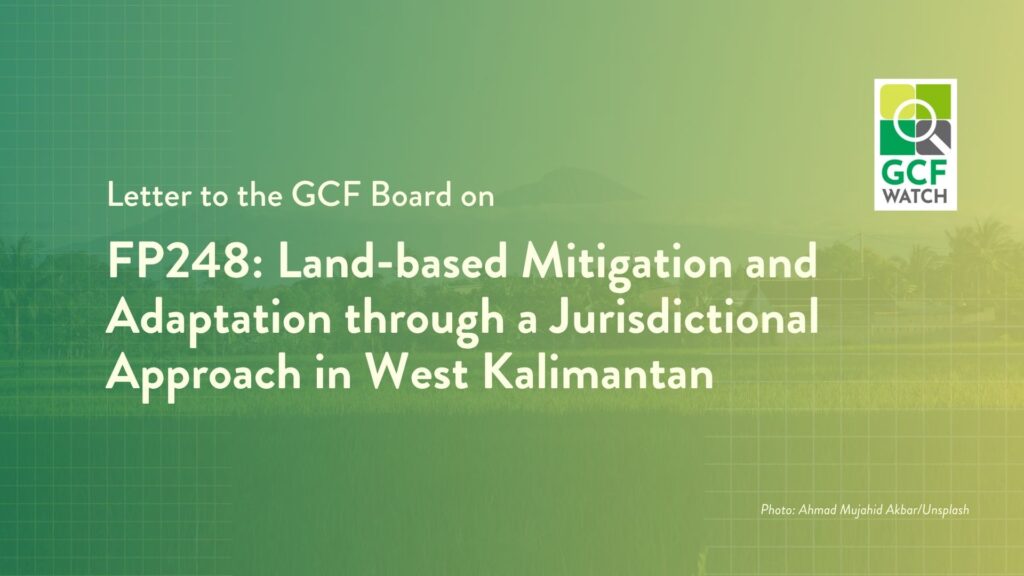BLOG: Understanding the mutual language of climate finance and advocacy
July 27, 2023 | Reposted from the Institute for Climate and Sustainable Cities (ICSC) | ACCESS THE FULL PIECE HERE
by Danize Marie Lukban
EDITOR’S NOTE: Danize is a climate policy analyst of ICSC, who was part of the delegation that participated in the 36th Board Meeting of the Green Climate Fund (GCF B.36) in Songdo, Incheon, South Korea last July 10-13, 2023. For more information on GCF B.36, you may visit the GCFWatch website.
As it was my first time attending a Green Climate Fund (GCF) board meeting, I was once again reminded of how far small actions can go.
Looking back to the events leading up to my interest in climate advocacy, I came across a series of photos of a girl sitting against a gloomy building of the Swedish parliament, beside her was a sign with “SKOLSTREJK FÖR KLIMATET” scribbled in big, bold letters.
“SCHOOL STRIKE FOR CLIMATE.”
These four words created a rippling effect across the globe in 2018 that is still felt today. Then-fifteen-year-old Greta Thunberg breathed new air into climate justice movements around the world. In her book No One Is Too Small to Make a Difference, Greta boldly called out, “The climate and the biosphere don’t care about our politics and our empty words for a single second.” In the face of climate change, her comments ring true on the non-urgent response of international leaders at the expense of lives lost, ecosystems threatened, and communities destroyed.
When it comes to discussions on climate finance, people are more often than not divided on areas of urgent concern, particularly on adaptation and loss & damages. It was evident in how decision-making in the GCF boardroom ricocheted between revisiting the language used and the set agenda over more pressing issues that included streamlining its accreditation and funding strategies. While it is inevitable for discord to occur in diplomacy, it gives more spotlight to small players, like civil society organizations (CSOs), to play a large role in reconciling politics and its overall mission. Through the help of these small players, climate justice issues are brought to light from the ground up, as they are anchored on climate reparation of the developed countries to the developing and the least developing countries.
In a 2023 study by the University of Leeds, it was found that by 2050, around USD 192 trillion can be mobilized and demanded as compensation by undershooting developing countries from overshooting advanced economies. The study identified which countries have taken the unfair share of emissions historically and have shown a trend of likelihood to overshoot their collective fair share of the 1.5° carbon budget, based on reports from the Intergovernmental Panel on Climate Change (IPCC).
It’s projected that the developed countries in the North, namely, the US owes at least USD 80 trillion shares, followed by the EU and the UK with USD 46 trillion, and the rest of the Global North with around USD 44 billion—totalling USD 170 trillion cumulative compensation. On top of that, select countries in the South that are also likely to overshoot their carbon emissions account for an additional USD 22 trillion. Overall, these countries are due to compensate an average of USD 940 per capita per year in the net zero scenario (2020 to 2050) to 101 undershooting countries.
When money is involved, it’s easy for wealthy and industrialized countries to rid themselves of accountability. This was seen in the history of international climate negotiations and the persisting climate denial narrative that began in the late 1970s. Eighteen years after the United Nations Framework Convention on Climate Change (UNFCCC) was established in 1992, it was only in 2010 that Green Climate Fund was founded as “an ambitious contribution to the global efforts towards the goals set by the international communities.”
Today, the GCF serves as a financial operating mechanism and the world’s largest multilateral climate fund under the Convention in support of the developing countries’ mitigation and adaptation efforts.
Civil society in the GCF
In highly polaristic arenas of dialogue such as the GCF board meeting, it is of crucial importance that observers from civil society, Indigenous Peoples, and local communities are present to bridge gaps between decision-makers and stakeholders. Observers elevate the voices of those who do not have the privilege of participating in this space, and at the same time, carry the burden of climate change impacts, to ensure that Board decisions are grounded on human rights, responsive to local needs, and helpful in conserving fragile ecosystems.
Before the official start of the 36th Meeting of the Green Climate Fund Board (B.36), Interim Executive Director Henry Gonzalez met with the observer network and reemphasized the critical role of the CSOs in climate finance discussions, “The Fund is becoming a better fund because of you.” While that may be true, the same sentiment cannot be said within the four corners of the large convention hall during board meetings. CSOs are often overlooked as small players in international discussions, as their interventions are only noted but not particularly considered in most decision-making processes.
Visibility of CSOs is as important as their presence. With consistency, combined with hope and a common goal for the future, CSO representatives were able to communicate interventions to the Board in a short period of time despite the small number of organizations that physically participated. I was also in awe of the strong voices of females from the group, which was led by two female Active Observers, with three female alternates and one male alternate, who is, in fact, ICSC’s executive director Angelo Kairos dela Cruz. It is uplifting to be surrounded by the sheer amount of energy of the group to continually engage with the Board members, the Secretariat, Independent Evaluation Unit, to name a few. It is in rare times like this that I realize that despite coming from different backgrounds, we all speak the same language in fighting for climate justice.
Big Moves in the GCF B.36
Adoption of Updated Strategic Plan for 2024-2027
After thorough and informal discussions from the previous board meetings over the years, the Updated Strategic Plan–which sets the outlook of the Fund for its next programming period from 2024-2027, also known as the GCF-2–was officially adopted by the Board. The Fund’s key programming direction for its second replenishment period puts a strengthened focus on enhancing country capacities and enabling environments for Nationally Determined Contributions (NDCs), National Adaptation Plans (NAPs), and Long-term Strategy (LTS) implementation; on supporting paradigm shifts while maintaining a 50/50 balance between adaptation and mitigation funding over time; on prioritizing immediate adaptation and resilience needs particularly for vulnerable countries; and on promoting innovation and green financing together with the private sector.
Canada as the fifth country to pledge for the GCF-2
On the evening of July 12 (South Korea time), the Canadian climate minister publicly announced the country’s USD 340.8 million contribution to the second replenishment of the GCF in a press conference in Brussels. At the Board Meeting the next day, Canadian Board Member Tom Bui was pleased to share Canada’s deepening support to the GCF, “Canada is happy to be the fifth country to pledge for the second replenishment period.” Following Czechia, Austria, Germany, and Monaco consecutively, Canada’s pledge was a 50 percent increase from the previous replenishment round. Tom emphasized the government’s satisfaction with the GCF and its successful and consistent delivery of its objectives, as seen in the GCF-1 Progress Report.
Approval of over USD 755.8 million in new climate projects
At the end of B.36, a total of 12 new funding proposals (FPs) were approved by the Board after undergoing rigorous vetting and reviewing processes, on top of the 188 projects currently under implementation. Over half of the programs are primarily focused on adaptation, with the funding recipients comprising countries such as Haiti, Pakistan, Bangladesh, South Africa, Barbados, and the Solomon Islands. The majority of the projects are aimed towards Least Developing Countries, Small Island Developing States, and African States.
—
2023 is considerably another big year for international climate discussions, following the release of the First Global Stocktake (GST) Synthesis Report and the GCF’s Second Replenishment Pledging. Climate Investment Funds CEO Mafalda Duarte’s onboarding as the incoming GCF Executive Director also marks another beginning for the Fund. High expectations are already laid down for the rest of the year and the succeeding years towards NDC updating in 2025.
While it is important to lay down stronger commitments, it is not through words that progress will be measured, but through accompanying actions that respond to the needs of humanity in the face of climate change.
####








